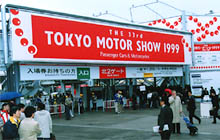 |
 |
 |
 |
 |
 |
|||||
 |
 |
 |
 |
|
GREEN MACHINES: Eco-Friendly Cars Steal the Show in Tokyo January 4, 2000  The Prius that was the first hybrid car to cross North America. (Toyota Motor Corp.) The race to make the ultimate environment-friendly car is picking up speed. The 33rd Tokyo Motor Show, which was held from October 23 to November 3, 1999, and is one of the largest car shows in the world, took on the appearance of an eco-motor show as domestic and foreign car makers unveiled their latest innovations in the battle to cut harmful exhaust gas emissions and reduce fuel consumption. The background to this frenzied eco-activity was the Third Session of the Conference of the Parties to the United Nations Framework Convention on Climate Change (COP3) in 1997, which set targets for reducing emissions of such greenhouse gases as carbon dioxide. The global environmental regulations that car manufacturers must comply with have been tightened, and consumers are becoming more and more concerned about the environment. The message is loud and clear: Car manufacturers must develop eco-friendly technology if they want to survive increasingly severe cut-throat competition. Introducing the Hybrid Car
Nissan Motor Co., Mitsubishi, and Mazda, each improving on their existing technology, introduced their own fuel-efficient, low-emission ecocars as well. One of the displays attracting particular attention was Honda Motor Co.'s experimental electric car, which is powered by what is perhaps the ultimate environmentally friendly energy source, a fuel cell, and was on public display for the first time. Survival of the Fittest Many countries reacted to COP3 by tightening environmental regulations governing motor vehicles. In Japan exhaust gas regulations will be made three times more strict than at present from October 2000, and stringent minimum fuel efficiency standards will come into force in 2010. As a consequence, under reforms to the tax system introduced in fiscal 1999 (April 1999—March 2000), cars that conform to the 2000 exhaust emission standards will be eligible for a 1% reduction in the automobile tax, and a family car meeting the 2010 minimum fuel efficiency standard will qualify for an automobile tax break of 15,000 yen (143 dollars at 105 yen to the dollar). So from now on car buyers will be able to choose one of these tax cuts. Also under consideration in the battle against greenhouse gases and air pollution was a "green tax" on cars, which would be higher or lower depending on the vehicle's environmental impact, but this has been rejected for the moment. It is thought that the cost of developing a fuel cell-powered car for commercialization will be more than one trillion yen (9.5 billion dollars). Creating new green technology in the future will clearly require huge amounts of capital, and that is why a worldwide reorganization in the motor industry was inevitable. The merger of Daimler-Benz and Chrysler, the tie-up between Renault and Nissan, and the capital-sharing agreement between Volvo and Mitsubishi are all direct reflections of this situation. The time is fast approaching when only those car makers at the cutting edge of environmental technology will survive.  Edited
by Japan Echo Inc. based on domestic Japanese news sources. Articles presented
here are offered for reference purposes and do not necessarily represent
the policy or views of the Japanese Government. Edited
by Japan Echo Inc. based on domestic Japanese news sources. Articles presented
here are offered for reference purposes and do not necessarily represent
the policy or views of the Japanese Government.
|


